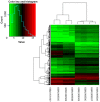Identification of differentially expressed genes in hip cartilage with femoral head necrosis, based on genome‑wide expression profiles
- PMID: 31322206
- PMCID: PMC6691263
- DOI: 10.3892/mmr.2019.10458
Identification of differentially expressed genes in hip cartilage with femoral head necrosis, based on genome‑wide expression profiles
Abstract
Necrosis of the femoral head (NFH), a severe orthopedic disease in adults, involves the collapse of the femoral head. The pathophysiological mechanisms underlying NFH are yet to be fully investigated. The aim of the present study was to identify potentially important genes and signaling pathways involved in NFH and investigate their molecular mechanisms. Gene expression profiles of patients with NFH and healthy controls were compared using the Gene Expression Omnibus (GEO) database repository of the National Center of Biotechnology Information. GSE74089 from the GEO database included 4 patients with NFH and 4 healthy individuals. A total of 1,191 differentially expressed genes (DEGs) were identified between the patients with NFH and controls, including 743 upregulated and 448 downregulated DEGs. Then, Gene Ontology and Kyoto Encyclopedia of Genes and Genomes pathway enrichment analysis revealed that upregulated DEGs were mainly involved in the phosphoinositide 3‑kinase/protein kinase B signaling pathway, focal adhesion and extracellular matrix‑receptor interactions. Additionally, protein‑protein interaction (PPI) analysis identified the most central DEGs as vascular endothelial growth factor A, Jun proto‑oncogene, cyclin D1, fibroblast growth factor 2, HECT domain and ankyrin repeat‑containing E3 ubiquitin protein ligase 1, protein kinase Cα, bone morphogenetic protein 2 and prostaglandin‑endoperoxide synthase 2. PPI analysis also identified guanine nucleotide‑binding protein, γ13 as the most commonly downregulated gene based on different centrality. The results of the present study may provide novel insight into the genes and associated pathways involved in NFH, and aid the identification of novel therapeutic targets and biomarkers in the treatment of NFH.
Figures



References
MeSH terms
LinkOut - more resources
Full Text Sources
Research Materials
Miscellaneous

